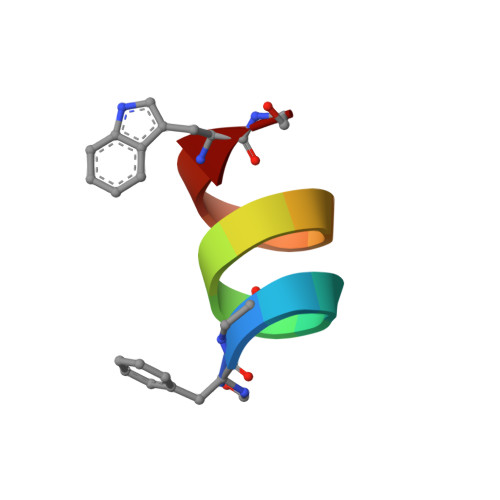The Structure, Cation Binding, Transport, and Conductance of Gly15-Gramicidin a Incorporated Into Sds Micelles and Pc/Pg Vesicles.
Sham, S.S., Shobana, S., Townsley, L.E., Jordan, J.B., Fernandez, J.Q., Andersen, O.S., Greathouse, D.V., Hinton, J.F.(2003) Biochemistry 42: 1401
- PubMed: 12578352
- DOI: https://doi.org/10.1021/bi0204286
- Primary Citation of Related Structures:
1NG8, 1NT5, 1NT6 - PubMed Abstract:
To further investigate the effect of single amino acid substitution on the structure and function of the gramicidin channel, an analogue of gramicidin A (GA) has been synthesized in which Trp(15) is replaced by Gly in the critical aqueous interface and cation binding region. The structure of Gly(15)-GA incorporated into SDS micelles has been determined using a combination of 2D-NMR spectroscopy and molecular modeling. Like the parent GA, Gly(15)-GA forms a dimeric channel composed of two single-stranded, right-handed beta(6.3)-helices joined by hydrogen bonds between their N-termini. The replacement of Trp(15) by Gly does not have a significant effect on backbone structure or side chain conformations with the exception of Trp(11) in which the indole ring is rotated away from the channel axis. Measurement of the equilibrium binding constants and Delta G for the binding of monovalent cations to GA and Gly(15)-GA channels incorporated into PC vesicles using (205)Tl NMR spectroscopy shows that monovalent cations bind much more weakly to the Gly(15)-GA channel entrance than to GA channels. Utilizing the magnetization inversion transfer NMR technique, the transport of Na(+) ions through GA and Gly(15)-GA channels incorporated into PC/PG vesicles has been investigated. The Gly(15) substitution produces an increase in the activation enthalpy of transport and thus a significant decrease in the transport rate of the Na(+) ion is observed. The single-channel appearances show that the conducting channels have a single, well-defined structure. Consistent with the NMR results, the single-channel conductances are reduced by 30% and the lifetimes by 70%. It is concluded that the decrease in cation binding, transport, and conductance in Gly(15)-GA results from the removal of the Trp(15) dipole and, to a lesser extent, the change in orientation of Trp(11).
- Department of Chemistry and Biochemistry, University of Arkansas, Fayetteville, Arkansas 72701, and Department of Physiology and Biophysics, Cornell University, Weill Medical College, New York, New York 10021.
Organizational Affiliation:


















